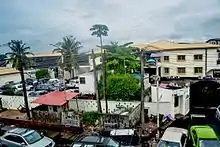Iga Idunganran
Iga Idunganran is the Official Residence of the Oba of Lagos, situated on Lagos Island.[1] It is also a tourist attraction.

History
Dating back to the 15th century, the Lagos Island was originally owned by the island's first inhabitant Chief Aromire, an Ile-Ife nobleman, who used it as a fishing post and pepper farm. The ancient palace was initially built in 1670 for Oba Gabaro (1669-1704).[2] It was later refurbished by the Portuguese, with materials — especially tiles — brought in from Portugal.[3]
and the modern part was completed and commissioned on 1 October 1960 by the Prime Minister of Nigeria, Abubakar Tafawa Balewa.[4] Recently modernized by the late Oba Adeniji Adele II and Oba Adeyinka Oyekan II, it underwent additional modernization in 2007/8 by the present Oba Akiolu in conjunction with the Lagos State government and the Nigerian Museum.[5]
Iga Idunganran has served as an administration centre, the island's market and hosted the Eyo festival.[6]
Name derivation
IGA, derived from the Oyo/Ife Yoruba language GAA meaning Royal Home or Palace, IDUN means land, place or sound of while IGANRAN is the Yoruba word for pepper. Iga Idunganran therefore translates to mean the palace built on a pepper farm, Aromire having used the land previously as a farm.[7]
The ancient tombs
All the Obas of Lagos before Oba Akitoye are buried in Benin City. Oba Akitoye was the first Oba of Lagos to be buried within the modern palace. All Obas except Sanusi Olusi and Kosoko are buried at Iga Idunganran.[4]
The ancient shrines of Iga-Idunganran
These include:
Èṣù
Esu (pronounced Éshu) can be found at the exit gate of the Palace. Esu was brought from Benin. It is also known by many other names, the most prominent of which is the devil which was borrowed from Christianity. The Oba and his chiefs prayed at this shrine to ward off danger to Lagos (and later Nigeria generally) in times past. They also prayed there prior to leaving the palace for any private or official function to ward off evil. Moreover, before going out, the Oba is supposed to visit this shrine in order to be told how his journey will be. Questions such as whether the journey will be favorable and whether it is safe for the Oba to embark on such a journey would typically be asked.
Ògún
Ogun is the undergod of iron. Though not within the palace per se, there is a small edifice constructed for immediate access in the complex's grounds. The main shrine is situated outside the present walls of the palace, though it still falls under its jurisdiction. It has a priestess who handles its day-to-day running.
Rites
Special rites/prayers are performed every sixteen days in the palace, usually by the Araba of Lagos, Chief Ajanaku, though the Oba does on occasion use other traditional priests and priestesses depending on the priority and the occasion, and the perceived spiritual prowess of such people. Some of the items necessary for performing these rituals are bitter kola, kola-nuts, alligator pepper, palm oil, schnapps or any plain gin, chickens, pigeons, goats or rams and anything else the Ifa oracle may decree, short of a human life.
See also
- Presidential Lodge, former presidential palace in Lagos
Further reading
References
- Kaye Whiteman (2013). Lagos: A Cultural and Literary History. Andrews UK Limited. ISBN 9781908493897.
- Okeagu Ogadah; Leonard N. Onwe; Philip Eworo (2005). Nigeria: cultural festivals & tourism sites directory, Volume 1. Federal Ministry of Cultural & Tourism. p. 106. ISBN 9780670556. Retrieved 4 May 2015.
- Smith, Robert (January 1979). The Lagos Consulate, 1851-1861. University of California Press, 1979. p. 8. ISBN 9780520037465.
- Folami, Takiu (1982). A History of Lagos, Nigeria: The Shaping of an African City. Exposition Press. pp. 65–66. ISBN 9780682497725.
- African Cities Driving the NEPAD Initiative. United Nations Human Settlements Programme. 2006. p. 258. ISBN 9211318157. Retrieved 4 May 2015.
- King, Anthony D. (1996). Representing the City. New York University Press. p. 118. ISBN 0814746799. Retrieved 4 May 2015.
- Williams, Lizzie (2008). Nigeria: The Bradt Travel Guide. Bradt Travel Guides. p. 110. ISBN 978-1841622392. Retrieved 4 May 2015.